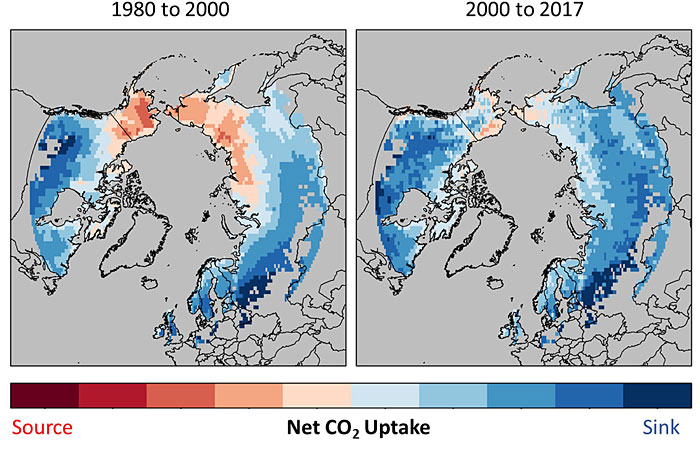UM Study Finds Plant Growth Offsets Carbon Release of Thawing Permafrost


MISSOULA – Permafrost is a layer of soil in polar and forested boreal regions that remains frozen all year. A new study from the University of Montana challenges the notion that high-latitude permafrost regions are becoming a net source of carbon dioxide that greatly contributes to climate warming.
The study was led by researchers in UM’s Numerical Terradynamic Simulation Group, a leader in satellite remote sensing and Earth-system science. Their findings were published in Nature Communications.
The team used satellites, ground stations and other observable data to reach its conclusions. The study revealed that a strong warming trend in northern regions has increased plant growth, which has offset rising CO2 emissions from thawing permafrost.
“Northern permafrost regions contain vast amounts of organic carbon in frozen soils,” said Ashley Ballantyne, the co-lead author and a UM professor of global climate and ecology. “This new study finds that enhanced photosynthetic CO2 uptake from plants is increasing faster than the warming-induced rise in emissions from the permafrost tundra region. In fact, the permafrost tundra region has become a strong CO2 sink.”
A CO2 sink takes in more carbon than it emits. John Kimball, the NTSG director and a UM professor of systems ecology, said their historical data revealed the permafrost tundra region shifted from a near-net-neutral condition in the 1980s to an ecosystem carbon sink around the turn of the century in 2000.
“This was caused by enhanced photosynthetic uptake due to warming, woody vegetation encroachment and other factors,” Kimball said. “These findings underscore the importance of looking at both carbon uptake and release to truly understand the net carbon exchange in permafrost ecosystems.”
At this time, he said, the primary mechanism for the regional carbon sink is enhanced CO2 uptake in the early growing season, which still is outpacing late-season carbon emissions.
Interestingly, the rate of net carbon uptake was weaker where the tree cover was greater in regions studied north of 50 degrees latitude. Consequently, though boreal forests remain strong carbon sinks, a trend toward rising CO2 emissions from microbial respiration from decomposing soil organic matter in the late growing season is offsetting more plant uptake of carbon early in growing seasons – potentially shrinking the net carbon sink in boreal forests.
“This is concerning because the results undermine the notion that northern high-latitude forests could become a long-term carbon sink,” Kimball said. “Enhanced CO2 release from thawing permafrost – together with other intensified disturbances – may ultimately switch boreal forest into a net carbon emitter as warming continues.”
Kimball said the study shows the need for global Earth-system models that better predict regional responses and feedbacks resulting from climate change.
“Next-generation satellite missions are planned that will provide new capabilities for landscape-level monitoring of permafrost conditions across the northern high latitudes,” he said. “These observations will have better spatial covering, resolution and sensitivity than current satellite records or ground station networks.
“We can’t wait.”
The UM-based researchers collaborated on the study with a group of 14 other scientists around the globe.
###
Contact: John Kimball, UM Numerical Terradynamic Simulation Group director, 406-243-4922, john.Kimball@umontana.edu; Ashley Ballantyne, UM associate professor of bioclimatology, 406-243-6791, ashley.ballantyne@umontana.edu.